2019届二轮复习语法专题动词时态语态课件(28张)
文档属性
| 名称 | 2019届二轮复习语法专题动词时态语态课件(28张) |  | |
| 格式 | zip | ||
| 文件大小 | 171.6KB | ||
| 资源类型 | 教案 | ||
| 版本资源 | 通用版 | ||
| 科目 | 英语 | ||
| 更新时间 | 2019-04-18 10:49:53 | ||
图片预览

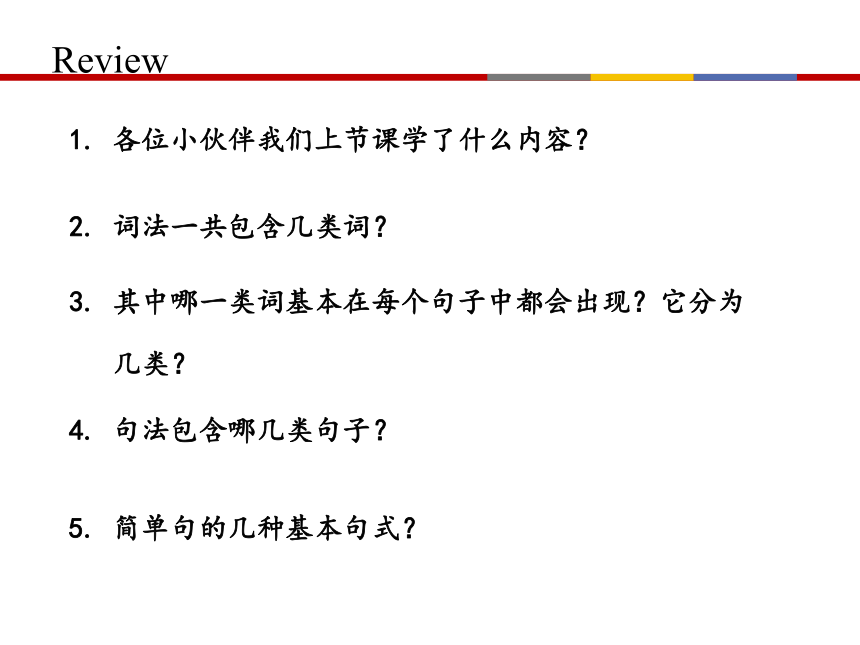


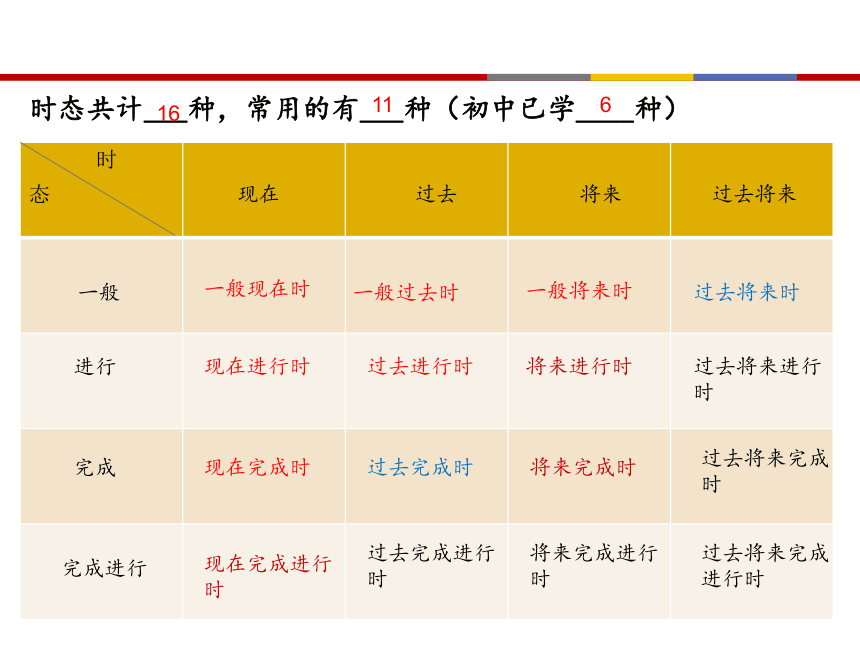
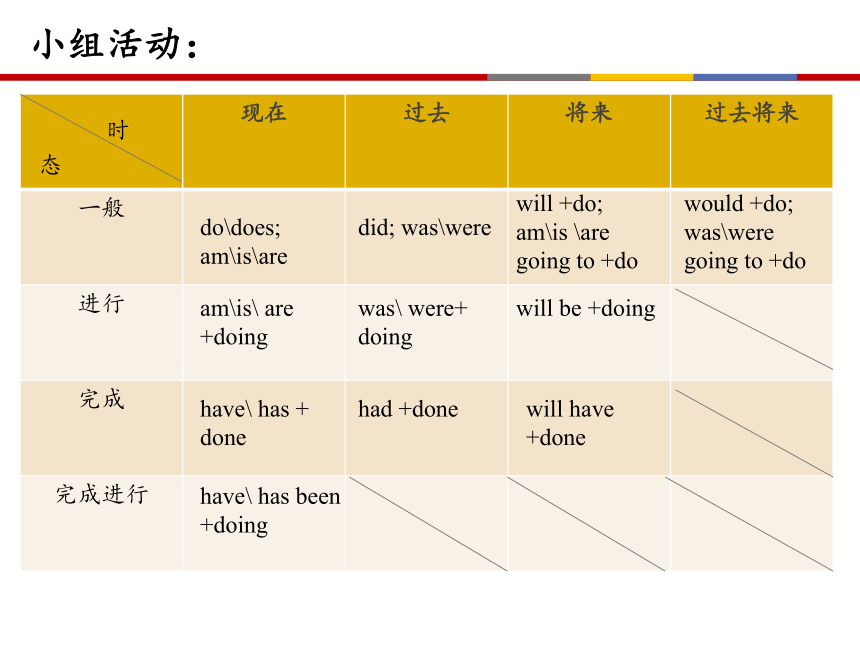

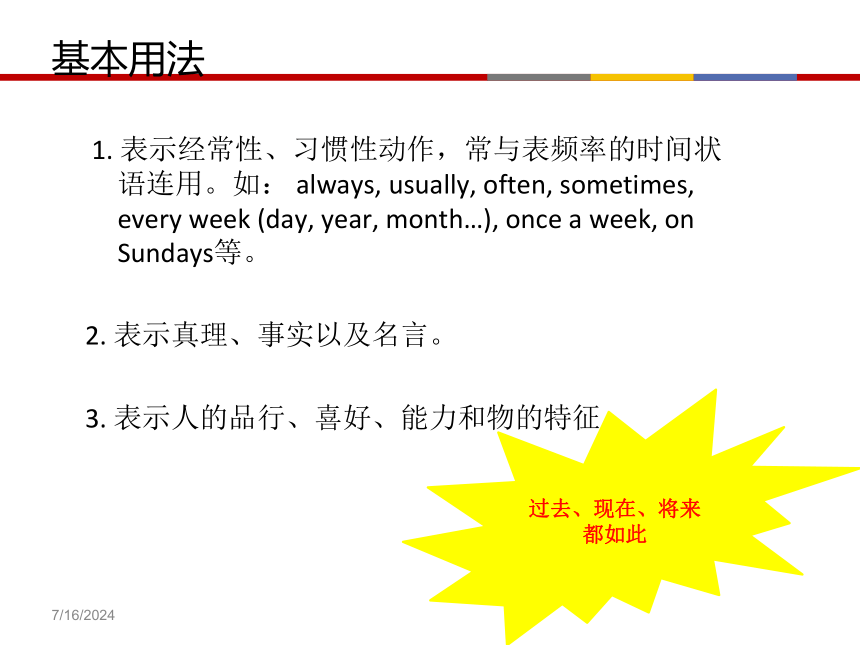
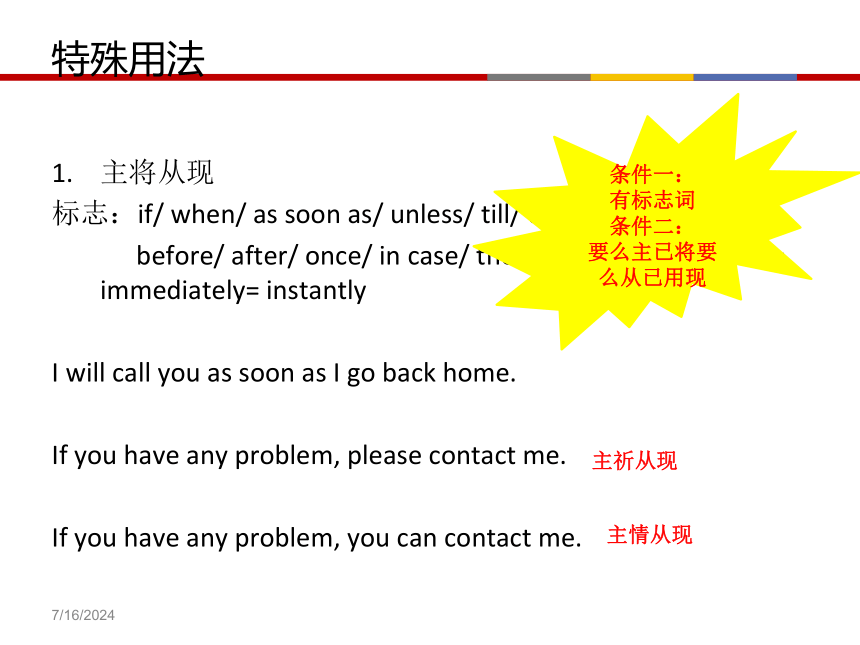
文档简介
课件28张PPT。2019届二轮复习语法专题
时态 Review2. 词法一共包含几类词?
5. 简单句的几种基本句式?
4. 句法包含哪几类句子?1. 各位小伙伴我们上节课学了什么内容?3. 其中哪一类词基本在每个句子中都会出现?它分为
几类?什么叫时态?8/4/2019动作、状态在某个时间条件下的动词形态时态共计___种,常用的有___种(初中已学____种)时态16116现在 将来 过去 过去将来 一般 进行 完成 完成进行
一般现在时一般过去时
一般将来时
过去将来时
现在进行时
过去进行时
将来进行时现在完成时过去完成时将来完成时现在完成进行时
过去将来进行时
过去将来完成时
过去将来完成进行时
将来完成进行时
过去完成进行时小组活动:时态dodoes; amisaredid; waswerewill +do; amis are going to +do would +do; waswere going to +do amis are +doingwas were+
doingwill be +doinghave has + donehad +donewill have +donehave has been +doing一般现在时形式
如何变单三
8/4/2019基本用法8/4/2019 1. 表示经常性、习惯性动作,常与表频率的时间状语连用。如: always, usually, often, sometimes, every week (day, year, month…), once a week, on Sundays等。
2. 表示真理、事实以及名言。
3. 表示人的品行、喜好、能力和物的特征。过去、现在、将来都如此特殊用法主将从现
标志:if/ when/ as soon as/ unless/ till/ until
before/ after/ once/ in case/ the moment= the minute= immediately= instantly
I will call you as soon as I go back home.
If you have any problem, please contact me.
If you have any problem, you can contact me.8/4/2019主情从现主祈从现条件一:
有标志词
条件二:
要么主已将要么从已用现特殊用法2.用于表示较固定的,按计划、规定将要发生的动作,但只限于begin, come, go, leave, arrive, stop, return, close, open, take, start, take place 等少数动作。
The train leaves Beijing at six and arrives at Jinan at nine.
8/4/2019不可改变的时刻表Exercises:1. The plane________ at 7: 00 p. m. ,so I have to be at the airport by ?6:40 at the
latest.
A.??has left B.?would ?leave C.?will have left D.?leaves
D2. A Midsummer Night’s Dream?______at the Theatre Royal on 19th June, and
then tours throughout Scotland.
A.?opens ? B.?is opened ??
C.?will open? D.?will be openedA3. Please give Jim the schedule for tomorrow’s conference when he ________
back. He is to chair the conference.
A.?will come??? ?????????????B.?is coming????????????????C.?comes?????????????????????D.?came
4. —Hey! What's the rush?
—The plane ______ at 4:00 and I need to see my uncle off.
A.?takes off B.?will take off
C.?has taken off D.?took off
Exercises:CA5. "Life is like walking in the snow", Granny used to say, "because every step_______”
A.?has shown B.?is showing?? C.?shows? D.?showed6. —Did you get to the railway station on time?
—Sure. The city center wasn’t as crowded this morning as it usually _____.
A.?is? B.?was? C.?has been? D.?had been?
Exercises:CA 一般过去时形式
如何变动词过去式和过去分词
8/4/2019用法1.表示过去某一具体时间发生的动作或存在的状态,常用的时间状语有last year, yesterday, just now, in +过去年份, a few years ago, in the past.
2.表示过去的经常性、习惯性动作或状态,常用的时间状语有always, often, usually, sometimes, seldom, never等。8/4/2019发生在过去与现在无关1. ---Oh, it’s you! I you. (not recognize)
---I have just had my hair cut, and I am wearing new glasses.
Exercises:didn’t recognize2. —The tickets to Texas are not available now.
—Oh. Flights _________ (sell)fast at festivals.
3. —That’s a great sweater. I have never seen anything like it
before.
— You think so? My grandmother __________ (make)it for me.
sell made一般将来时结构与用法:
“will/ shall + 动词原形”,shall仅用于第一人称I/we作主语,而will 则用于各种人称。时间状语有:next time, tomorrow, this afternoon, before long,in the future, soon, the day after tomorrow.
“be going to + 动词原形”,表示打算、计划、安排做某事。
8/4/2019注意一:shall/will do和be going to do的区别
1. shall/will do表示一种趋势或预言将要发生的事;be going to do表示有迹象发生。
The world will come to an end in the near future.(主观预言)
Look at these clouds! It’s going to rain.(迹象发生事情)
2. shall/ will do表示临时性打算;be going to do表示提前计划、安排好的事情。
We haven’t seen each other for a long time. Shall we have a dinner tonight?(临时性的打算)
We are going to have a meeting at 8:00 tomorrow.(计划、安排)
8/4/2019结构与用法:
“be about + to+动词原形”,表示即将发生某事,不与具体的将来时间状语连用。
“be to + 动词原形”,表示即将发生某事、安排做某事或要求做某事。
8/4/2019结构与用法:
⑤begin, leave, arrive, start, finish, meet, return等动词的一般现在时,表示按计划或安排将要发生的事。(时刻表)
⑥leave, go, come, stay, do, take, have 等动词的现在进行时,表示按计划或准备要做某事。
8/4/2019注意二:一般现在时表将来和现在进行时表将来的区别
一般现在时表示计划、安排将要发生事情的时候主语通常为物(火车、飞机等的时刻表,有具体的时刻)
The train leaves Beijing at 7:00.
现在进行时表示计划、安排将要发生事情的时候主语通常为人。
They are having a meeting tonight.
8/4/2019现在进行时形式
如何变动词现在分词形式
8/4/2019基本用法 常用的时间状语有:now, right now, at present, at this moment, these days.
① 表示说话时正在进行的动作或存在的状态
The telephone is ringing now. Please answer it.
② 表示现阶段正在进行,但说话时未必正在进行
Today the number of people learning English in China is increasing rapidly.
I’m getting along well with a boy in my class.
8/4/2019特殊用法 ① 表示按计划或安排将要发生的动作,用于go, come, stay, leave, do, take, have等少数动作,往往表示“马上就,即将,逐渐地,反复的”。
② 与always, forever, constantly, frequently等副词连用,表示赞扬或厌恶的感彩。
试比较:He always finishes his homework on time. (习惯)
He is always finishing his homework on time. (赞扬)
③ 用于表示“变化”的动词(如become, get, turn等),强调“逐渐变化”的过程。
例:It is getting hotter and hotter.
8/4/2019过去进行时形式
用法
① 表示过去某一时刻正在进行的动作
② 表示过去某一时间内正在进行的动作
③ 表示一个动作发生时,另一个动作正在进行
8/4/2019句型:when V.S while
A. When sb. ... did sth., sb. ... was/were doing
当我到家的时候,妈妈正在做饭。
?
B. When sb. ... was/were doing, sb. ... did sth.
当我写作业的时候,妈妈回来了。
?
C. When sb. ... did sth., sb. ... did sth.
当我停车的时候,有个人冲我走来。
D. While sb. ... was/were doing, sb. ... was/were doing (只接延续性动词)
当我写作业的时候,哥哥在玩电脑。
8/4/2019将来进行时形式
用法
① 表示将来某一时间或某一时刻正在进行的动作,常用的时间状语有this time tomorrow, at 10 o’clock next Monday, in a minute。
② 与一般将来时连用,表示在将来某一动作之后要做的事情。
8/4/2019谢谢
5. 简单句的几种基本句式?
4. 句法包含哪几类句子?1. 各位小伙伴我们上节课学了什么内容?3. 其中哪一类词基本在每个句子中都会出现?它分为
几类?什么叫时态?8/4/2019动作、状态在某个时间条件下的动词形态时态共计___种,常用的有___种(初中已学____种)时态16116现在 将来 过去 过去将来 一般 进行 完成 完成进行
一般现在时一般过去时
一般将来时
过去将来时
现在进行时
过去进行时
将来进行时现在完成时过去完成时将来完成时现在完成进行时
过去将来进行时
过去将来完成时
过去将来完成进行时
将来完成进行时
过去完成进行时小组活动:时态dodoes; amisaredid; waswerewill +do; amis are going to +do would +do; waswere going to +do amis are +doingwas were+
doingwill be +doinghave has + donehad +donewill have +donehave has been +doing一般现在时形式
如何变单三
8/4/2019基本用法8/4/2019 1. 表示经常性、习惯性动作,常与表频率的时间状语连用。如: always, usually, often, sometimes, every week (day, year, month…), once a week, on Sundays等。
2. 表示真理、事实以及名言。
3. 表示人的品行、喜好、能力和物的特征。过去、现在、将来都如此特殊用法主将从现
标志:if/ when/ as soon as/ unless/ till/ until
before/ after/ once/ in case/ the moment= the minute= immediately= instantly
I will call you as soon as I go back home.
If you have any problem, please contact me.
If you have any problem, you can contact me.8/4/2019主情从现主祈从现条件一:
有标志词
条件二:
要么主已将要么从已用现特殊用法2.用于表示较固定的,按计划、规定将要发生的动作,但只限于begin, come, go, leave, arrive, stop, return, close, open, take, start, take place 等少数动作。
The train leaves Beijing at six and arrives at Jinan at nine.
8/4/2019不可改变的时刻表Exercises:1. The plane________ at 7: 00 p. m. ,so I have to be at the airport by ?6:40 at the
latest.
A.??has left B.?would ?leave C.?will have left D.?leaves
D2. A Midsummer Night’s Dream?______at the Theatre Royal on 19th June, and
then tours throughout Scotland.
A.?opens ? B.?is opened ??
C.?will open? D.?will be openedA3. Please give Jim the schedule for tomorrow’s conference when he ________
back. He is to chair the conference.
A.?will come??? ?????????????B.?is coming????????????????C.?comes?????????????????????D.?came
4. —Hey! What's the rush?
—The plane ______ at 4:00 and I need to see my uncle off.
A.?takes off B.?will take off
C.?has taken off D.?took off
Exercises:CA5. "Life is like walking in the snow", Granny used to say, "because every step_______”
A.?has shown B.?is showing?? C.?shows? D.?showed6. —Did you get to the railway station on time?
—Sure. The city center wasn’t as crowded this morning as it usually _____.
A.?is? B.?was? C.?has been? D.?had been?
Exercises:CA 一般过去时形式
如何变动词过去式和过去分词
8/4/2019用法1.表示过去某一具体时间发生的动作或存在的状态,常用的时间状语有last year, yesterday, just now, in +过去年份, a few years ago, in the past.
2.表示过去的经常性、习惯性动作或状态,常用的时间状语有always, often, usually, sometimes, seldom, never等。8/4/2019发生在过去与现在无关1. ---Oh, it’s you! I you. (not recognize)
---I have just had my hair cut, and I am wearing new glasses.
Exercises:didn’t recognize2. —The tickets to Texas are not available now.
—Oh. Flights _________ (sell)fast at festivals.
3. —That’s a great sweater. I have never seen anything like it
before.
— You think so? My grandmother __________ (make)it for me.
sell made一般将来时结构与用法:
“will/ shall + 动词原形”,shall仅用于第一人称I/we作主语,而will 则用于各种人称。时间状语有:next time, tomorrow, this afternoon, before long,in the future, soon, the day after tomorrow.
“be going to + 动词原形”,表示打算、计划、安排做某事。
8/4/2019注意一:shall/will do和be going to do的区别
1. shall/will do表示一种趋势或预言将要发生的事;be going to do表示有迹象发生。
The world will come to an end in the near future.(主观预言)
Look at these clouds! It’s going to rain.(迹象发生事情)
2. shall/ will do表示临时性打算;be going to do表示提前计划、安排好的事情。
We haven’t seen each other for a long time. Shall we have a dinner tonight?(临时性的打算)
We are going to have a meeting at 8:00 tomorrow.(计划、安排)
8/4/2019结构与用法:
“be about + to+动词原形”,表示即将发生某事,不与具体的将来时间状语连用。
“be to + 动词原形”,表示即将发生某事、安排做某事或要求做某事。
8/4/2019结构与用法:
⑤begin, leave, arrive, start, finish, meet, return等动词的一般现在时,表示按计划或安排将要发生的事。(时刻表)
⑥leave, go, come, stay, do, take, have 等动词的现在进行时,表示按计划或准备要做某事。
8/4/2019注意二:一般现在时表将来和现在进行时表将来的区别
一般现在时表示计划、安排将要发生事情的时候主语通常为物(火车、飞机等的时刻表,有具体的时刻)
The train leaves Beijing at 7:00.
现在进行时表示计划、安排将要发生事情的时候主语通常为人。
They are having a meeting tonight.
8/4/2019现在进行时形式
如何变动词现在分词形式
8/4/2019基本用法 常用的时间状语有:now, right now, at present, at this moment, these days.
① 表示说话时正在进行的动作或存在的状态
The telephone is ringing now. Please answer it.
② 表示现阶段正在进行,但说话时未必正在进行
Today the number of people learning English in China is increasing rapidly.
I’m getting along well with a boy in my class.
8/4/2019特殊用法 ① 表示按计划或安排将要发生的动作,用于go, come, stay, leave, do, take, have等少数动作,往往表示“马上就,即将,逐渐地,反复的”。
② 与always, forever, constantly, frequently等副词连用,表示赞扬或厌恶的感彩。
试比较:He always finishes his homework on time. (习惯)
He is always finishing his homework on time. (赞扬)
③ 用于表示“变化”的动词(如become, get, turn等),强调“逐渐变化”的过程。
例:It is getting hotter and hotter.
8/4/2019过去进行时形式
用法
① 表示过去某一时刻正在进行的动作
② 表示过去某一时间内正在进行的动作
③ 表示一个动作发生时,另一个动作正在进行
8/4/2019句型:when V.S while
A. When sb. ... did sth., sb. ... was/were doing
当我到家的时候,妈妈正在做饭。
?
B. When sb. ... was/were doing, sb. ... did sth.
当我写作业的时候,妈妈回来了。
?
C. When sb. ... did sth., sb. ... did sth.
当我停车的时候,有个人冲我走来。
D. While sb. ... was/were doing, sb. ... was/were doing (只接延续性动词)
当我写作业的时候,哥哥在玩电脑。
8/4/2019将来进行时形式
用法
① 表示将来某一时间或某一时刻正在进行的动作,常用的时间状语有this time tomorrow, at 10 o’clock next Monday, in a minute。
② 与一般将来时连用,表示在将来某一动作之后要做的事情。
8/4/2019谢谢
